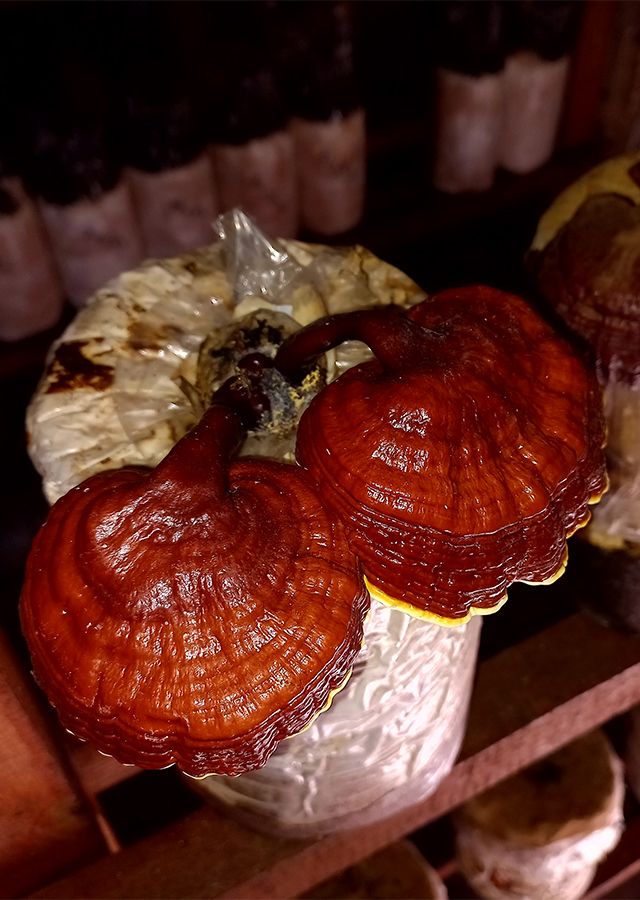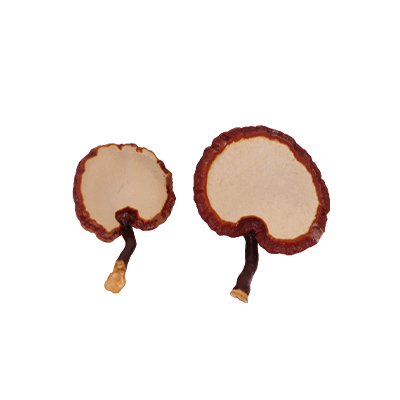Lingzhi Mushroom
Ganoderma lucidum (Curtis) P.Karst.
Ganodermataceae
Location in our garden
Mushroom House



Synonym
Boletus lucidus Curtis
Polyporus lucidus (Curtis) Fr.
Habitus
Fern. An annual polyporous, shelf fungus
Part Used
The Whole Plant
Growing Requirements
Need Shade
High Rainfall
Habitat
Wetland
Riverbanks
Forest
Roadside
Grassland
Terrestrial
Overview
Ganoderma lucidum is a reddish laccate species of Ganoderma with a limited distribution in Europe and parts of China, where it grows on decaying hardwood trees. Wild populations have been found in the United States in California and Utah, but were likely introduced anthropogenically and naturalized. In Chinese, the name lingzhi represents a combination of spiritual potency and essence of immortality, and is regarded as the “herb of spiritual potency,” symbolizing success, well-being, divine power, and longevity. Lingzhi has been recognized as a medicinal mushroom for over 2000 years, and its powerful effects have been documented in ancient scripts.
Vernacular Names
Lingzhi (Chinese), Reishi (Japanese).
Agroecology
Ganoderma lucidum is parasitic on live hardwood (particularly oak) and saprophytic on deadwood of hardwood. Most often found growing on fallen hardwoods, or at the base of live trees. It is a relatively slow growing mushroom that prefers a temperature around 75-85 degrees Fahrenheit, and a high humidity (75-85% relative humidity). It requires some shaded light to develop properly. Lingzhi requires fresh air, but drying drafts must be avoided. It likes a high humidity, but does not like to be continuously damp. A dirty or dusty environment increases the chance of mould or insect pest problems.
Morphology
- The spore print of G. lucidum is brown. Cells are non-motile, with rigid cell walls containing chitin.
- The basal unit of G. lucidum is the hyphae which embed in live or dead wood substrate, and allow for heterotrophic nutrient absorption through enzyme secretion and breakdown of organic wood material.
- The fruiting body of G. lucidum is varnished reddish brown, with soft brown flesh that hardens quickly with age. Young tissue may also include yellows and lighter browns, or whites.
- A cap of 2-30 cm; at first knobby, but by maturity more or less fan-shaped can grow on a stem, causing white rot at the base, either alone or in clusters.
Cultivation
Propagation using spores (located at the bottom of the hood), taken from mature fungi.
Chemical Constituents
Polysaccharides (peptide polysaccharides), adenosine, triterpenes, phenols, amino acids, steroids, nucleotides, ergosterol, coumarins, ganodespurine alkaloids, ganoderiol A, ganoderiol B, ganosporelactone A, ganosporelactone B, ganodermatriol, ganolactone, ganoderic acid.
Traditional Medicinal Uses
- This fungus was claimed to possess antimicrobial, antiviral activity, including antihuman immunodeficiency virus (HIV), antiaging activity, antioxidant activity, anti-inflammatory activity, immunomodulating activity, anti-HUC-PC growth properties, antitumor activity through inhibiting proliferation and inducing apoptosis of cancer cells, reducing tumor invasiveness, immunomodulating effect, and modulating signaling.
Part Used
Reference Sources
- Wachtel-Galor S, Yuen J, Buswell JA, et al. Ganoderma lucidum (Lingzhi or Reishi). (2011). https://www.ncbi.nlm.nih.gov/books/ NBK92757/. 11-10-21.
- Science Direct. Ganoderma lucidum. https://www.sciencedirect.com/topics/agricultural-and-biological-sciences/ganoderma-lucidum. 11-10-21.
- Microbe Wiki. Ganoderma lucidum. (2011). https://microbewiki.kenyon.edu/index.php/Ganoderma_lucidum. 11-10-21.
- Richters. Reishi Mushroom Kit Growing Instructions. https://www.richters.com/show.cgi?page=InfoSheets/d4845.html. 11-10-21.

